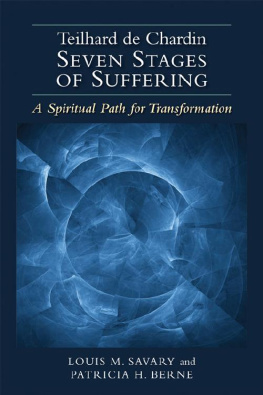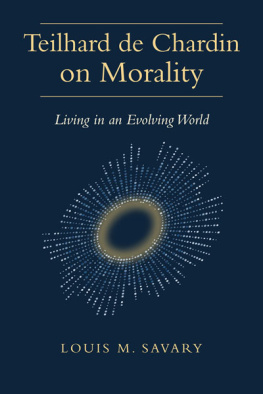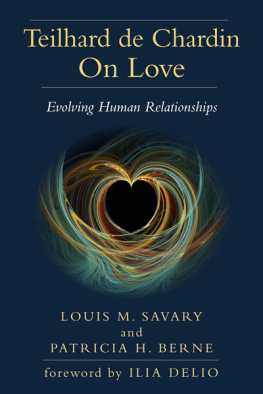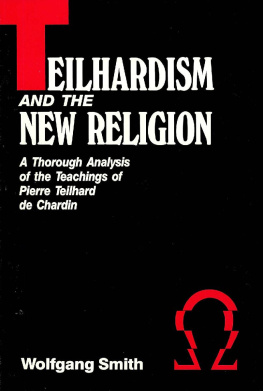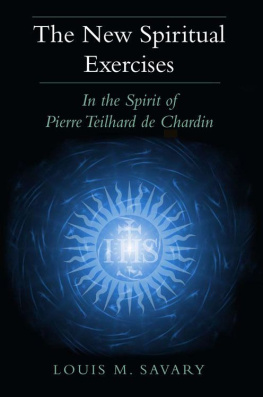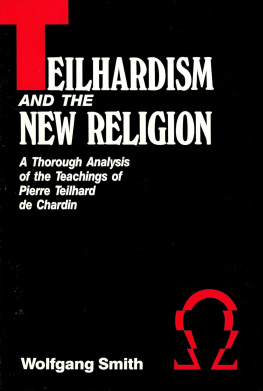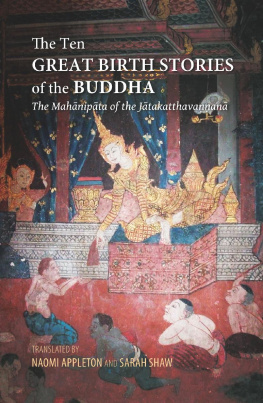When first published, Teilhard de Chardins seminal work attracted worldwide attention and immediately became a bestseller, but few realized then how many mistakes the first translation contained. Sarah Appleton-Weber has done us a great service by providing a much more exact, more coherent and more poetic text based on many years of meticulous research. This fresh translation invites readers to enter and share Teilhards powerful vision of science and religion, of the direction and meaning of life in a world so large and complex. It is a vision of great spiritual significance and strength. It provides a perspective of hope, energy, love and meaningful coherence which can inspire and uplift peoples lives.
Professor Ursula King, University of Bristol, author of Spirit of Fire: The Life and Vision of Teilhard de Chardin
This book reads so splendidlywith precision, fidelity, beauty of presentation, comprehensiveness, forcefulness... it has a magic quality you dont find in writing in the science world. This new translation of the The Human Phenomenon gives us a new Teilhard. No one so far has caught the lyric style of Teilhard so well as the author of this translation. A precise understanding of Teilhards style of writing is especially important, for the nuances of his thought are so subtle that any translation that fails in this regard will necessarily fail in transmitting the full meaning of his thought. We have now, for the first time, this most comprehensive work of Teilhard in a translation worthy of its importance. This translation will in the future be the basic text for any serious study of Teilhard in the English language.
Thomas Berry, co-author of The Universe Story,
and author of The Great Work
This is an entirely new and authoritative translation by Sarah Appleton-Weber of the original French text of The Human Phenomenon by Teilhard de Chardin. It will provide scholars, and the general reader, with a manuscript that is faithful in every detail not only to the epic quality and vibrant energy of Teilhards thought but also to nuances of expression so important to an in-depth understanding of the theological, philosophical and scientific implications which he intended.
James W. Skehan, SJ, Professor and Director Emeritus,
Weston Observatory, Boston College
Teilhardians have long been aware of limitations in the standard English version of Le phnomne humain . Now they have access to a new and felicitous translation by Sarah Weber. But Weber offers more than a new translation, for she has spent years visiting archives and restoring passages that were lost as Teilhard and others revised the original text. Now we have access to a stunning new version of a twentieth-century classic.
Thomas M. King, SJ, Georgetown University,
author of Teilhards Mysticism of Knowing
and Teilhard de Chardin ; co-editor of
Teilhard and the Unity of Knowledge
and Letters of Teilhard de Chardin
and Lucile Swan
The Teilhard de Chardin Foundation (Paris) endorses Ms Webers new translation, which will undoubtedly contribute to spreading the thought of Teilhard in English-speaking countries.
Maurice Ernst, Administrator Delegate,
Fondation Teilhard de Chardin, Paris
One of the most significant debates in evolutionary history has been postponed into the twenty-first century. That is, the intellectual clash between the schools of purpose and direction within evolution with the modernist schools of randomness and non-teleology. Sarah Webers new translation of Telhards major work, The Human Phenomenon , comes just as these schools seek to clarify their positions. Teilhards work occupies a central role in these discussions not only because of his prescient understandings of complexity and convergence in the emergence of life, but also because of his concerns regarding the deeper spiritual meanings in contemplating evolution.
Teilhards insights find prominent expression in the increasingly intense discussions on religion and science. In addition to her painstaking translation, Sarah Weber provides in her introduction helpful keys for an initial understanding of the novel literary genre which Teilhard used in his work, namely, his description of the unfolding of cosmological powers in the history of the Earth.
John A. Grim, Department of Religion,
Bucknell University
THE HUMAN
PHENOMENON
Pierre Teilhard de Chardin
The best of my thought and time
goes into writing the book on the human,
which I have told you about, where I am trying
to transmit the essential part of my vision of the world:
thought rooted in matter, and by the very fact of its awakening,
calling for the reality of some sort of superlife. Just what you have
created in your Man Emerging out of the Elemental Forcesthe
best possible illustration for the frontispiece of my book...
If my pages could be ready when the war has ended
when human beings will truly feel the need of
building and hopingmy time
will not have been wasted .
T EILHARD TO M ALVINA H OFFMAN
P EKING , J ANUARY 14, 1940
The quotation is courtesy of the Getty Research
Institute, Research Library, 850042
THE HUMAN
PHENOMENON
Pierre Teilhard de Chardin
A New Edition and Translation
of Le phnomne humain by
Sarah Appleton-Weber
With a Foreword by
Brian Swimme

Copyright Sarah Appleton-Weber, 2021.
Published in the Sussex Academic e-Library, 2019.
SUSSEX ACADEMIC PRESS
PO Box 139, Eastbourne BN24 9BP, UK
Ebook editions distributed worldwide by
Independent Publishers Group (IPG)
814 N. Franklin Street
Chicago, IL 60610, USA
ISBN 9781902210308 (Paperback)
ISBN 9781782847151 (Epub)
ISBN 9781782847151 (Kindle)
ISBN 9781782847151 (Pdf)
All rights reserved. Except for the quotation of short passages for the purposes of criticism and review, no part of this publication may be reproduced, stored in a retrieval system, or transmitted, in any form or by any means, electronic, mechanical, photocopying, recording or otherwise, without the prior permission of the publisher.
British Library Cataloguing in Publication Data
A CIP catalogue record for this book is available from the British Library.
This e-book text has been prepared for electronic viewing. Some features, including tables and figures, might not display as in the print version, due to electronic conversion limitations and/or copyright strictures.
CONTENTS
ILLUSTRATIONS
Cover picture : Photograph by Steven Santori (Syracuse University Photo Center) of Malvina Hoffmans bronze statue of Elemental Man, or, as Teilhard described it, Man emerging out of elemental forces, which stands on the campus grounds of Syracuse University.
Note : The frontispiece and inside cover are not printed in this 2015 paperback edition. Frontispiece : A photo-portrait of Teilhard taken by Malvina Hoffman in preparation for making her final bust of Teilhard prior to preparing her sculpture. The photo is reproduced courtesy of the Getty Research Institute, Research Library, 850042. Inside cover : Facsimile of the Delamarre medal, struck by the French Mint, Paris, 1951. The reverse is based on a design by Teilhard to illustrate his idea of convergence.
The Human Phenomenon
Editor-Translators Appendix
ACKNOWLEDGMENTS
Without the cooperation, encouragement, and support of both the French and American Teilhard Associations, this new English edition and translation of Le phnomne humain could never have been completed. Through the late Jeanne Mortier, I received permission to work with the earlier texts of Le phnomne humain , and through her successor as General Secretary of the Fondation Teilhard de Chardin in Paris, Simone Clair-Michot, I was given access to material in the archives of the Fondation. I also received the warm support of Maurice Ernst, Administrator Delegate of the Fondation and head of the Association des Amis de Pierre Teilhard de Chardin; and the art and friendship of Anne-Marie Caffort-Ernst have been an inspiration to me. Under the leadership of Maurice Ernst, the French, American, and Canadian Associations have signed a charter of cooperation with the British Teilhard Association, and with other European Associations. My particular thanks go to Sin Cowell, Chairman of the British Teilhard Association, for reading the text and for essential suggestions about important terms. I extend a warm thank you to the British Committee, and Association members, for organizing the formal launch of this edition at the Reform Club in London. It is much appreciated.
Next page


